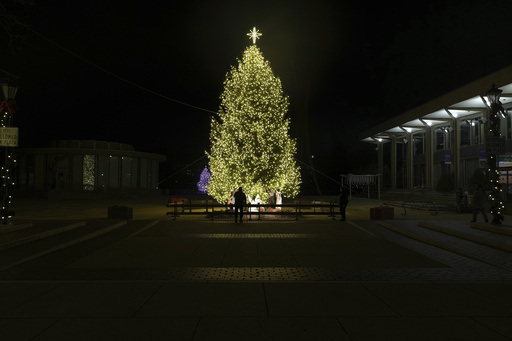
BETHLEHEM, Pa. — On December 24, 1741, the Moravian settlers christened this Pennsylvania city after the birthplace of Jesus in the Bible. Nearly three centuries later, the Moravian community continues to honor the Christmas season with cherished traditions in Bethlehem.
Among these traditions is the “putz,” a Nativity display that narrates the story of the birth of Christ using intricately crafted miniature figures. Additionally, thousands of beeswax candles are made by hand, signifying the light that Jesus brought to the world. Another tradition is the “lovefeast,” where congregants gather for a service that includes a simple meal of sweet buns and coffee shared within their pews.
“As with all Moravian traditions, the significance lies in fostering togetherness,” shared the Rev. Janel Rice, senior pastor at Central Moravian Church, the first Moravian congregation in Bethlehem and the oldest Moravian church across North America. “Our core belief is about building community and placing that above doctrine or dogma.”
Rice noted that Moravians resonate with the story of Jesus, Mary, and Joseph due to their own history as a refugee church fleeing persecution. The Nativity remains a poignant symbol today, particularly amidst the ongoing global rise in displaced individuals due to conflict and oppression.
“This narrative transcends time; it’s not merely about Jesus 2,000 years ago, but about the stories of today. We are called to extend refuge and compassion to those in need,” church member Sarah Wascura emphasized.
Historically, the Moravian Church is one of the oldest Protestant denominations, originating from the regions of Bohemia and Moravia, now part of the Czech Republic. The movement began with the reformist John Hus, who advocated for church practices to align with the language of the congregants rather than Latin, which was the norm. Unfortunately, Hus was labeled a heretic and executed in 1415. This spurred his followers to establish the Moravian Church, known as Unitas Fratrum (Unity of Brethren), in 1457, predating Martin Luther’s Reformation.
Facing persecution, Moravians trekked to Herrnhut, Germany, where they formed the original Renowned Moravian Church settlement. Determined to share their faith, Moravian missionaries eventually made their way to Pennsylvania.
On Christmas Eve in 1741, during a visit from their leader Count Nicolas Ludwig von Zinzendorf, they sang the hymn “Jesus Call Thou Me” near a stable, whose lyrics professed Bethlehem as the birthplace of Christ. Inspired by this moment, he named the new settlement Bethlehem.
The original settlers brought carved figures to depict the story of Christ’s birth, giving rise to the tradition known as the putz, derived from the German term “putzen,” meaning to embellish or decorate.
“This tradition harks back to the creches of the Middle Ages,” Rice explained, noting that it extends beyond a single Nativity scene. Instead, it employs figures to illustrate various Gospel events, such as the Annunciation and the Magi’s visit.
During Victorian times, residents practiced the custom of “putzing” by visiting homes between Christmas Eve and New Year’s to admire each other’s Nativity displays. In 1937, a campaign by the local chamber of commerce began promoting Bethlehem as “Christmas City USA.” This initiative included bringing the putz tradition to the historic Hotel Bethlehem, leading to so many visitors that the church was invited to host the display.
Ever since, the community putz has been assembled by church members and showcased in the nearby Christian education building. “It’s about more than just Christmas for those four weeks,” Wascura remarked, sharing that she met her husband during a visit to the putz. “This city’s faith heritage is a source of pride that is deeply woven into its identity.”
During a recent event, Wascura guided families to their seats as she shared the Moravian Church’s rich history alongside tales from Bethlehem. When the curtain opened, it revealed a stunning display of wooden figures—angels, shepherds, and kings within a beautifully designed miniature landscape made of pebbles, wood, and moss.
As they listened to the recorded narration by Janel Rice, she posed an interesting question: “Why is setting up a putz and recounting Jesus’s birth significant for Moravians and the city of Bethlehem?”
Following a choir performance, the resonant tones of the Moravian Trombone Choir filled the air, known for their rich sound from the belfry of Central Moravian Church. When the lights illuminated the scene, children eagerly gathered to explore details of the figures, including small zebras, lions, and even giraffes near the manger.
Visitor Kelly Ann Ryan expressed her excitement at the historical significance of Bethlehem, saying, “We’re fortunate to live so close to a city with such a rich Christmas history. It’s an unmissable tradition for our family.” She visited with her husband and their two sons to experience the community putz, which has become a cornerstone of their holiday celebrations. “Connecting with the Christmas story this way is a beautiful experience for kids.”
Christmas in Bethlehem is all-encompassing, blending sacred and secular elements. Recently, Santa Claus arrived outside Central Moravian, inviting families to join him on a sleigh ride drawn by horses. Nearby, holiday decorations adorned shops along Main Street, while visitors mingled with vendors selling ornaments at the Christkindlmarkt, all beneath the illuminated remnants of the once-thriving Bethlehem Steel.
At Central Moravian, families gathered as the choir sang hymns, and sacristans distributed buns and mugs of coffee to those attending the “lovefeast.” After a heartfelt blessing from Rice, Linda Thudium retrieved a huge closet filled with handmade candles, which symbolize the Christmas season for many.
Reflecting on this tradition, Thudium remarked, “For me, this is Christmas—these candles evoke magical memories that date back to when I was five. I cherish sharing this with my children and grandchildren. It’s a warmth that connects me to this church and its history.”

